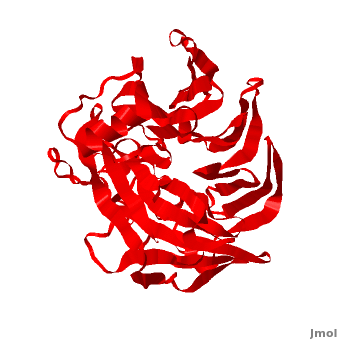Nucleoporin
From Proteopedia
(Difference between revisions)
| (30 intermediate revisions not shown.) | |||
| Line 1: | Line 1: | ||
| - | + | <StructureSection load='' size='350' side='right' caption='Yeast nucleoporin NUP159 N-terminal domain (PDB entry [[1xip]])' scene='Nucleoporin/Cv/1'> | |
| - | + | == Function == | |
| + | [[Nucleoporin|Nucleoporins]] (NUP) are constituents of the nuclear pore complex which regulates the flow of macromolecules across the nuclear envelope. They are named according to their molecular weights. They contain a domain which binds the protein RAN (RANBD), N-terminal domain (NTD) and C-terminal domain (CTD)<ref>PMID:9159086</ref>. <br /> | ||
| + | *'''NUP1P''' is a yeast nucleoprotein required for nuclear protein import, mRNA export and maintenance of nuclear architecture<ref>PMID:8045927</ref>. <br /> | ||
| + | *'''NUP2P''' is a yeast nucleoprotein required for bidirectional transport of importin α<ref>PMID:11046143</ref>. <br /> | ||
| + | *'''NUP Gle1''' is a yeast and human nucleoprotein required mRNA export. <br /> | ||
| - | + | == Disease == | |
| + | NUP98 and NUP214 gene translocation is associated with myeloid and lymphoid malignancies. NUP88 is over expressed in ovarian tumors. NUP214 is the functional receptor of adenovirus 2 nucleocapsids<ref>PMID:14693424</ref>. | ||
| - | '''Nucleoporins (NUP)''' are constituents of the nuclear pore complex which regulates the flow of macromolecules across the nuclear envelope. They are named according to their molecular weights. They contain a domain which binds the protein RAN (RANBD). The images at the left and at the right correspond to one representative Nucleoporin structure, ''i.e.'' crystal structure of yeast Nucleoporin NUP159 from ''Saccharomyces cerevisiae'' ([[1xip]]), | ||
| - | |||
| - | {{TOC limit|limit=2}} | ||
== 3D Structures of Nucleoporin == | == 3D Structures of Nucleoporin == | ||
| + | [[Nucleoporin 3D structures]] | ||
| + | </StructureSection> | ||
| - | + | == References == | |
| - | + | <references/> | |
| - | [[ | + | [[Category:Topic Page]] |
| - | + | ||
| - | + | ||
| - | + | ||
| - | + | ||
| - | + | ||
| - | + | ||
| - | + | ||
| - | + | ||
| - | + | ||
| - | + | ||
| - | + | ||
| - | + | ||
| - | + | ||
| - | + | ||
| - | + | ||
| - | + | ||
| - | + | ||
| - | + | ||
| - | + | ||
| - | + | ||
| - | + | ||
| - | + | ||
| - | + | ||
| - | + | ||
| - | + | ||
| - | + | ||
| - | + | ||
| - | + | ||
Current revision
| |||||||||||
References
- ↑ Doye V, Hurt E. From nucleoporins to nuclear pore complexes. Curr Opin Cell Biol. 1997 Jun;9(3):401-11. PMID:9159086
- ↑ Belanger KD, Kenna MA, Wei S, Davis LI. Genetic and physical interactions between Srp1p and nuclear pore complex proteins Nup1p and Nup2p. J Cell Biol. 1994 Aug;126(3):619-30. PMID:8045927
- ↑ Solsbacher J, Maurer P, Vogel F, Schlenstedt G. Nup2p, a yeast nucleoporin, functions in bidirectional transport of importin alpha. Mol Cell Biol. 2000 Nov;20(22):8468-79. PMID:11046143
- ↑ Cronshaw JM, Matunis MJ. The nuclear pore complex: disease associations and functional correlations. Trends Endocrinol Metab. 2004 Jan-Feb;15(1):34-9. PMID:14693424
Proteopedia Page Contributors and Editors (what is this?)
Michal Harel, Joel L. Sussman, Alexander Berchansky, Jaime Prilusky

